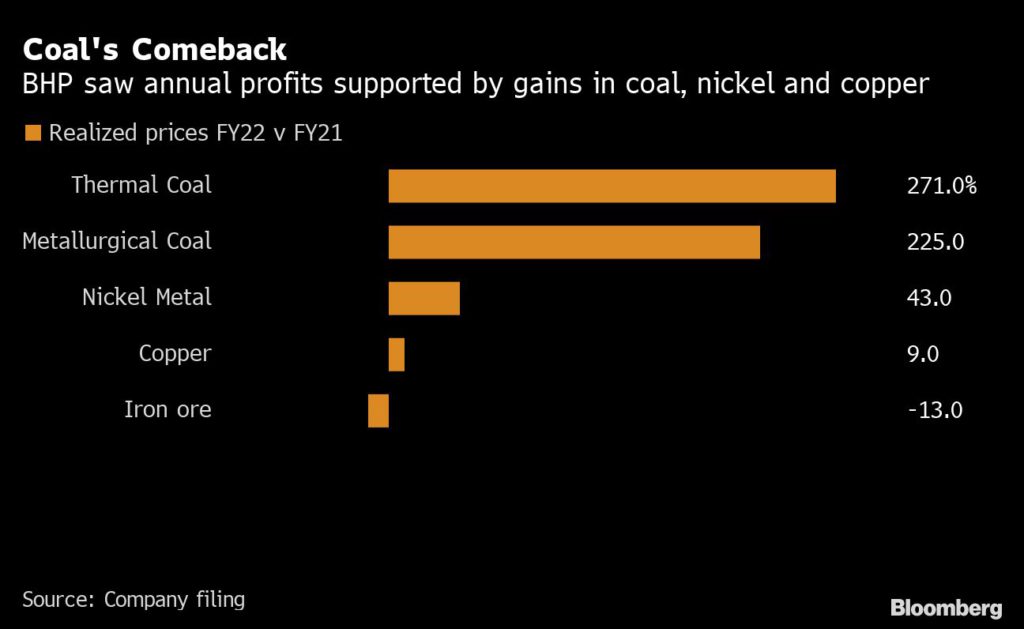Why BHP reckons China’s economy is poised to improve

BHP Group, the world’s biggest miner, unveiled a record profit on gains in prices of commodities from coal to nickel, and offered some optimism on Beijing’s efforts to reboot Chinese growth and stabilize the ailing property sector.
China’s infrastructure and automotive sectors are “already responding to policy support,” although a rebound in housing activity is expected to take longer, the producer said.
Here are the company’s key views on global growth and its key commodity markets:
Global growth
On China, BHP expects demand to improve in fiscal 2023, although it also nodded to lingering risks from Covid-19 lockdowns and the deep slump in construction. The world’s No.2 economy will be a source of stability in the coming year and “perhaps something much more than that” if property activity recovers.

The company flagged weaker growth in other key regions stemming from geopolitics and Covid-19. “This is particularly evident in advanced economies, as central banks pursue anti-inflationary policy and Europe’s energy crisis is an additional source of concern,” BHP said.
Steel
Though there should be a steady improvement in China’s demand, a “slower than expected rebound in construction post Covid-19 lockdowns has dampened sentiment across the steel value chain,” BHP said. Elsewhere in the world, profitability for steelmakers is also declining on weaker demand and markets are likely to remain under pressure this fiscal year as the macroeconomic climate softens.
Iron ore
The steel-making ingredient is likely to remain in surplus through fiscal year 2023, BHP said, noting stronger supply from big miners and more competition from scrap. Key near-term uncertainties are the pace of steel end-use demand recovery in China, disruptions to seaborne supply, and Chinese steel output cuts. Looking further, BHP said Chinese steel production and iron ore demand will plateau in the mid-2020s.
Copper & nickel
As always, BHP flagged the long-term prospects of these metals, given their exposure to the “electrification mega-trend”. But immediate prospects are more mixed. The miner sees both metals moving out of deficit conditions as supply improves, particularly for nickel, and as demand outside China worsens, particularly for copper. On copper: “We believe mine supply and scrap collection will grow in the next few years, covering near-term demand growth.”
Coking coal
After touching record highs, prices for coal used in steel-making face uncertainty over China’s import policy and Russian exports. The key seaborne supply region of Queensland has become “less conducive to long-life capital investment” after announcing plans to raise royalties on producers, BHP said. The fuel will still be used in blast-furnace steel-making for decades, supporting long-term demand, the producer said.
Thermal coal
Energy coal also broke price records as trade flows were redirected from Asia to Europe as a result of curbs on Russian exports and on gas-to-coal switching as LNG prices spiked, BHP said. Over the longer-term, total primary energy derived from coal — both for power and other uses — is expected to be challenged, particularly under deep decarbonization scenarios where demand is expected to decline, BHP said.
Potash
Prices experienced gains on strong demand and worries over a loss of supply from Belarus and Russia, which account for about 40% of global output. The crop nutrient “stands to benefit from the intersection of numerous global mega-trends: rising population, changing diets and the need for the sustainable intensification of agriculture on finite arable land,” BHP said.
(By David Stringer)
More News
Rio Tinto, Founders Factory’s Mining Tech Accelerator invests in startups from US and OZ
April 23, 2025 | 04:02 pm
{{ commodity.name }}
{{ post.title }}
{{ post.date }}



Comments